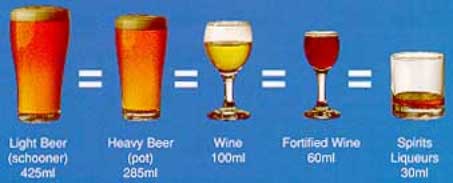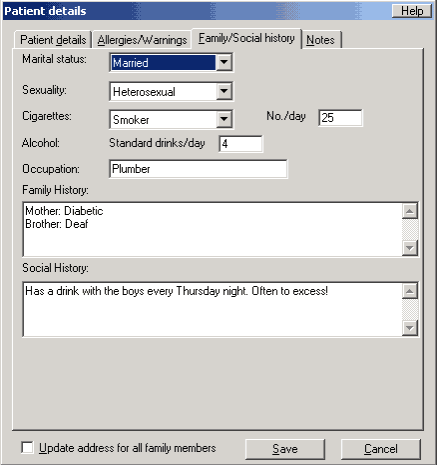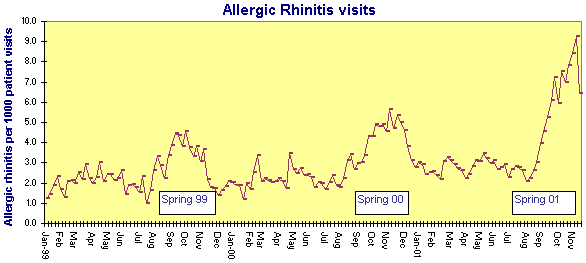Home
Article
Archive
2000 2001
Editor:
Neil Johnston
Columnists:
Rollo
Manning
Leigh Kibby
Jon
Aldous
Roy Stevenson
Brett Clark
Ken Stafford
Pat Gallagher
Heather Pym
Simon
Rudderham
Mark
Coleman
James
Ellerson
Terry
Irvine
Roundup
Peter
Sayers
Stephen Rogers
HCW
DECEMBER, Edition # 39, 2001
[Home] [About The Newsletter] [Topics Covered] [Testimonials]
Issue 29 - 26th November 2001
This week:
Monitoring alcohol use in GP patients
Measuring alcohol risk
GP recording of 'standard drinks per day'
Alcohol consumption of GPRN patients
What can GPs do?
Recording Alcohol Consumption in MDData updates
Allergic rhinitis surveillance
Top 20 Medications*The GPRN is a national Australian database of general practice data, provided by participating GPs for research purposes. The data is: anonymous patient management information electronically collected from Medical Director users who have agreed to take part longitudinal with information dating back to 1 Jan 1999 updated on a weekly basis
Health Communication Weekly covers Up-to-date information on current issues in general practice, ways to use Medical Director (MD) more effectively, information on best practice,evidence-based medicine and topics that interest you.
email us at research@hcn.com.au
Click on the Newsletter Reader's Forum link to access a forum from which you can express your comment or viewpoint on this article.
The author values your input, so please take the time to register your details, and participate in the only free debate on the future of Australian pharmacy.
Registration is free, and required once only, for permanent access.
You do not need to register if you only wish to view comments.
Computachem Editor's Note:
We are pleased to announce that we have formed an alliance with Health Communications Network (HCN), an Australian company that is heavily involved in e-health. With permission, we have extracted focus items from their recent newsletter which should prove of interest to pharmacists.
Note that the second item, the top 20 prescriptions written by GP's is provided by the GPRN database noted above.Measuring alcohol risk
Alcohol is second to tobacco as the greatest cause of drug-related mortality in Australia.(1)
Mathers et al(2) estimated that alcohol consumption accounted for 4.9% of the total burden of disease in Australia in 1996 but, because low consumption of alcohol can protect against some diseases, the net burden was 2.2%.
Early intervention is a proven and effective method of reducing alcohol consumption in early stage problem drinkers before greater harm can be done.(3,4,5)
Research has shown brief advice from a GP can result in a 25-30% reduction in alcohol consumption and a 45% reduction in the number of excessive drinkers.(5)
It is estimated that at one in three encounters with adult patients, the GP will be dealing with a person drinking 'at risk' levels of alcohol.(6)This HCW looks at:
* how often GPs record alcohol consumption in their electronic patient record.
*levels of alcohol consumption recorded for GPRN patientsIn Medical Director patient alcohol consumption can be recorded as number of standard drinks per day in the Social/family history section of the Patient Details. Recording of alcohol use is valuable because of:
1. the potential impact on health of excess alcohol consumption
2. the opportunity to provide brief advice if appropriate.Data used: Data from the GPRN database for visits between January 1999 and October 2001 were examined.
We were interested in*the proportion of doctors who recorded information in the "Standard drinks per day" field in the patient history
* the proportion of their patients for whom it was recorded.
Patients aged less than 18 were not included.
GP recording of 'standard drinks per day'
Of the 287 GPs participating in the GPRN since January 1999, 59% had made at least one recording for patient consumption of alcohol.However, the proportion of total patients who had any alcohol recording at all was small (5.4%). There were only 29,423 valid recordings of standard drinks per day for adult patients (>18 yrs) in the GPRN database. Males made up of 48.5% of these.
There are several possible explanations for the low levels of recording of alcohol consumption:
* GPs may not usually record alcohol consumption as a standard part of the history, * GPs may record it in a paper file but not in MD,
* GPs may not record it in this field.Alcohol consumption of patients in the GPRN

From the Queensland Health Department’s Making sense of Standard Drinks resources.
A standard drink contains 10 grams of alcohol.
The following are equivalent to one standard drink:
* 1 schooner of light beer (425mls)
* 1 middy of full strength beer (285mls)
* 1 small glass of wine (100 mls).
* 1 small glass of fortified wine (60mls) 1 nip of spirits (30 mls)Table 1 shows levels of alcohol consumption in the GPRN data and risk by patient age and sex. The recordings made were grouped according to the definition of risk below. Definitions 'At risk' levels of alcohol consumption according to NHMRC guidelines(3) are as follows:
* for men - more than 4 standard drinks per day
* for women - more than 2 standard drinks per day(3)More than 6 standard drinks per day for males, or more than 4 standard drinks per day for females is considered a harmful level of alcohol consumption.(2)
Table 1: Alcohol consumption by age group. Alcohol consumption (standard drinks per day) Age group 18-24 25-44 45-64 65-74 75+ MALES Non-drinker 50.1 31.1 28.4 32.5 42.6 Moderate drinker 47.4 60.7 59.5 58.5 53.3 'At risk' drinker 2.5 8.2 12.2 9 4.1 FEMALES Non-drinker 64.8 51.3 50.8 63.8 71.5 Moderate drinker 33.7 44.9 43.9 33 25.7 'At risk' drinker 1.6 3.9 5.3 3.3 2.8 GPRN database at 31 Oct 2001 – proportions based on patients with alcohol consumption recorded
In the GPRN data, 50% of males and 64.8% of females in the 18-24 age group were non-drinkers. The largest proportion of 'at risk' drinkers was in the 45-64 year age group – in which 12.2% of males and 5.3% of females were at risk.In a 1995 survey of the general population, 14.6% of males and 12.7% of females reported 'at risk' levels of drinking.(3)
In the GPRN data presented here, 8.4% of males and 3.6% of females had 'at risk' levels of alcohol consumption.
The differences could be due to the fact that GPRN data is passively collected, and that only one piece of information is available to calculate risk.
Frequency and quantity of alcohol consumption would provide a more complete estimate of risk.
There may also be biases in the types of GPs who record alcohol usage, or the patients for whom they record such information.
It is also possible that patients under-report alcohol use to their doctor.GPRN data could be improved by more complete recording of alcohol information. However, it would still be possible to investigate cohorts of patients who have their status recorded and the health events related to different levels of risk.
What can GPs do?
The time of recording and updating patient history is an opportunity for GPs to briefly enquire about alcohol and if appropriate, provide brief advice about the levels of alcohol consumption that may increase risk. Recording of alcohol consumption is important for diagnostic and preventive health reasons.
GPs can
* Be aware of high risk levels of alcohol consumption
* Ask patients about alcohol consumption
* Record and monitor alcohol consumption
* Educate and advise when appropriate
* Relate alcohol consumption to the presenting problem when appropriate.References
1. Higgins K, Cooper-Stanbury M and Williams P 2000. Statistics on drug use in Australia 1998. AIHW cat. No. PHE 16. Canberra AIHW (Drug Statistics Series).
2. Mathers C, Vos T, and Stevenson C 1999. The burden of disease and injury in Australia. AIHW Cat. No. PHE 17. Canberra: Australian Institute of Health and Welfare.
3. Mattick RP and Jarvis T 1993. An outline for the management of alcohol problems: quality assurance project, Canberra: AGSP. National Health and Medical Research Council (NHMRC) 1992. Is there a safe level of daily consumption of alcohol for men and women?: Recommendations regarding responsible drinking behaviour. Canberra: AGPS.
4. Bien TH, Miller WR and Tonigan JS 1993. Brief interventions for alcohol problems: a review. Addiction 88: 315-36
5. Richmond R and Anderson P 1994. Research in general practice for smokers and excessive drinkers in Australia and the UK 1. Interpretation of results. Addiction 89:35-40.
6. Sayer GP, Britt H, Horn F, Bhasale A, McGeechan K, Charles J, Miller G, Hull B, Scahill S 2000. Measures of health and health care delivery in general practice in Australia. AIHW Cat. No. GEP3. Canberra: Australian Institute of Health and Welfare (General Practice Series no. 3).Recording Alcohol Consumption in MD
Patient Details > Family/Social History
Or click on any patient detail field (eg name) and go to the Family/Social history tab. Alcohol consumption can be recorded in the field, by asking the patient how many standard drinks a day they consume on average. Additional information about alcohol usage could be recorded in the notes section.
Allergic rhinitis surveillance
The chart below shows the rate of Allergic Rhinitis visits per 1000 up till 18 November 2001.
Allergic rhinitis visits are where Allergic Rhinitis or hay fever recorded as diagnosis Mometasone or Ipratropium nasal spray prescribed.
These two products were chosen as their indications are specifically Allergic Rhinitis and not other Allergic conditions.
Part of the challenge of surveillance of this condition is that a large proportion of the treatments are available over-the-counter.
Nonetheless, for those patients requiring more aggressive therapy, GPRN data should reflect the seasonal nature of the condition.
The chart suggests a higher number of visits this year’s Spring than the previous 2 years.
Top 20 Medications prescribed in General Practice this week
(weighted by no of repeats)
This month Last month This year Generic medication Rank Percent Rank Percent Rank Percent Salbutamol sulfate
1 2.9 1 3.04 1 3.08 Atorvastatin
2 2.66 2 2.59 3 2.46 Simvastatin
3 2.29 3 2.57 2 2.52 Paracetamol
4 2.16 4 2.16 6 2.06 Omeprazole magnesium
5 2.01 6 1.87 13 1.39 Ranitidine hydrochloride
6 1.86 7 1.79 4 2.21 Celecoxib
7 1.77 5 1.9 5 2.16 Atenolol
8 1.73 9 1.64 7 1.68 Fluticasone propionate/salmeterol xinafoate
9 1.48 11 1.45 21 1.01 Rofecoxib
10 1.44 10 1.56 18 1.1 Amoxycillin
11 1.44 8 1.66 9 1.43 Paracetamol/codeine phosphate
12 1.42 12 1.37 12 1.39 Methadone
13 1.37 48 0.61 51 0.63 Irbesartan
14 1.32 14 1.29 10 1.41 Levonorgestrel/
ethinyloestradiol15 1.28 13 1.35 8 1.43 Perindopril erbumine
16 1.25 20 1.11 17 1.14 Sertraline hydrochloride
17 1.24 17 1.23 11 1.39 Temazepam
18 1.17 15 1.24 14 1.27 Metformin hydrochloride
19 1.15 16 1.24 15 1.22 Ramipril
20 1.11 18 1.23 19 1.05
This month = four weeks ending 18 Nov 2001
Last month = four weeks ending 21 October 2001
This year = 19 Nov 2000 to 18 Nov 2001
Last data supplied: 18 November 2001
Data source: GPRN Health Communication
Network Editorial Review: Geoffrey Sayer * Dr Frank Pyefinch
Contributing Authors: Fiona Horn * Leigh Hendrie * Kevin McGeechan * Geoffrey Sayer
Editor: Alice Bhasale
Health Communication Network,
PO Box 67 St Leonards NSW 1590 ph 02 9906 6633 email: research@hcn.com.au.
Ends
Back
to Article Index
Newsletter Reader's
Forum
|
||||
|
||||
|
*
Please contact us if you would like further information or would like us to research additional material to publish as future articles. |
*
Don't forget to advise of any change in your e-mail address so that your subscription may be continued without interruption. |
*
Letters to the editor are encouraged, or if you have material you would like published, please forward to the editor. |
*
Any interested persons who would like to receive this free newsletter on their desktop each fortnight, please send a single word e-mail "Subscribe" |
*
|
|
*
All Communications to:
neilj@computachem.com.au |
||||
|
*
You are invited to visit the Computachem web site and check out
an organised reference site for medical or other references.
Why not try (and bookmark) the Computachem Interweb Directory for an easily accessed range of medical and pharmacy links, plus a host of pharmacy relevant links. The directory also contains a very fast search engine for Internet enquiries. You may also access the Home Page at: http://www.computachem.com.au |
||||



